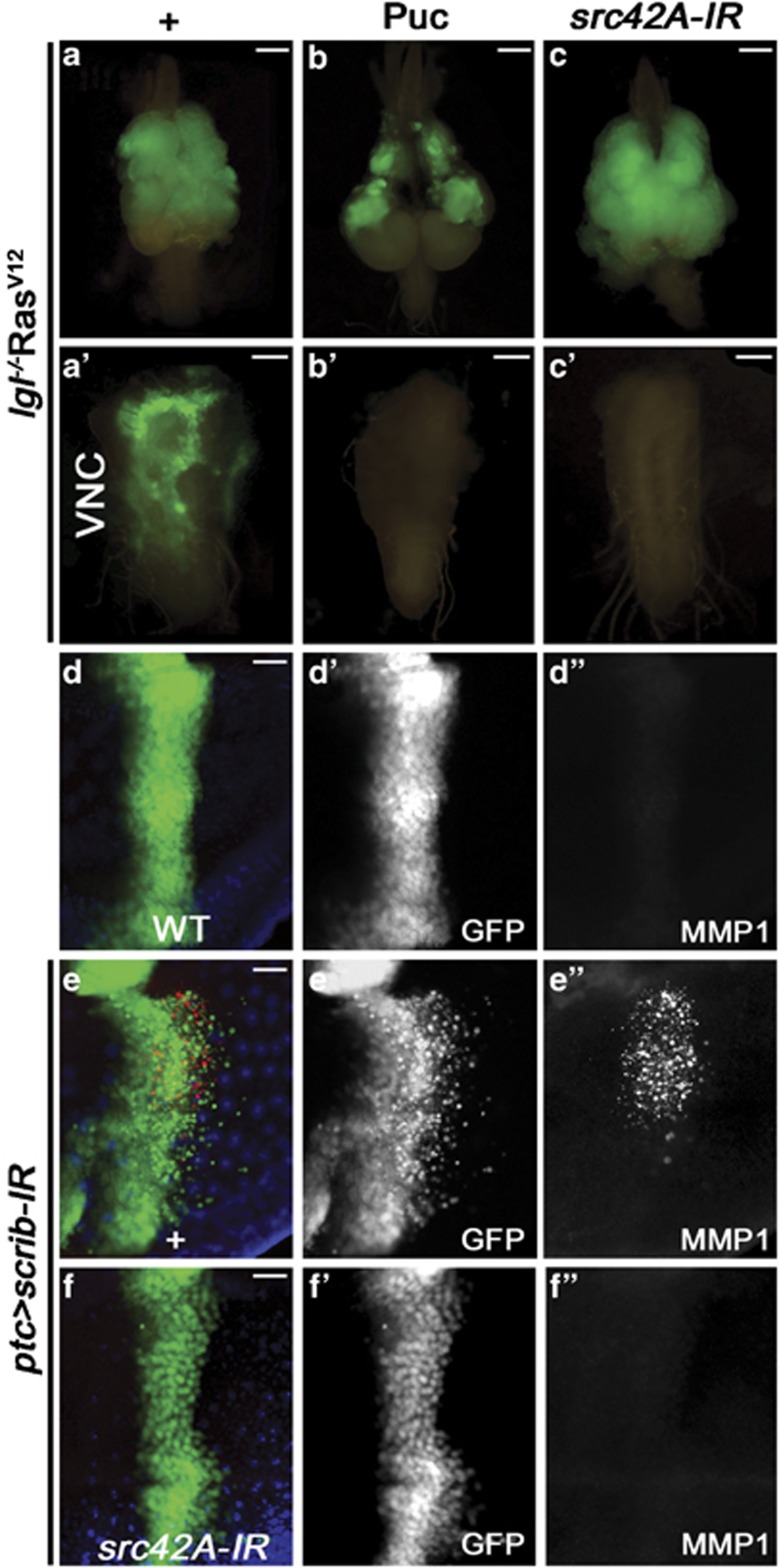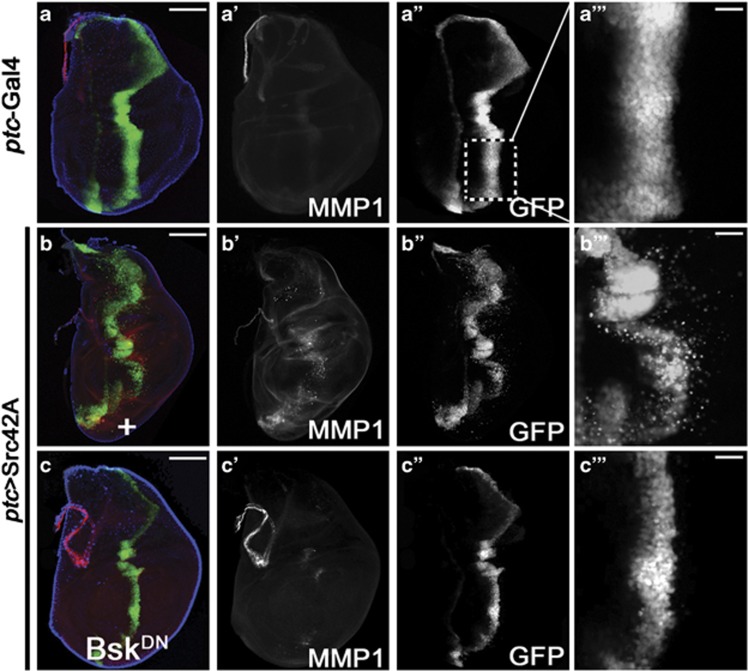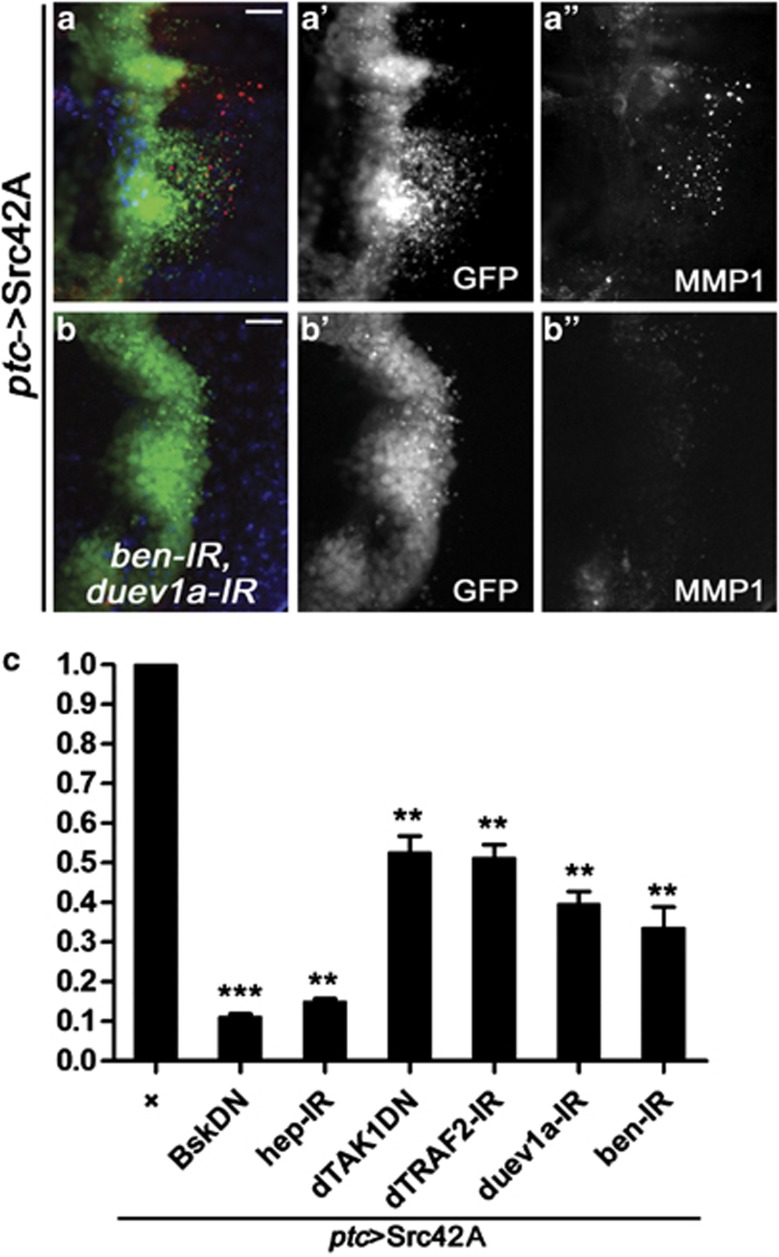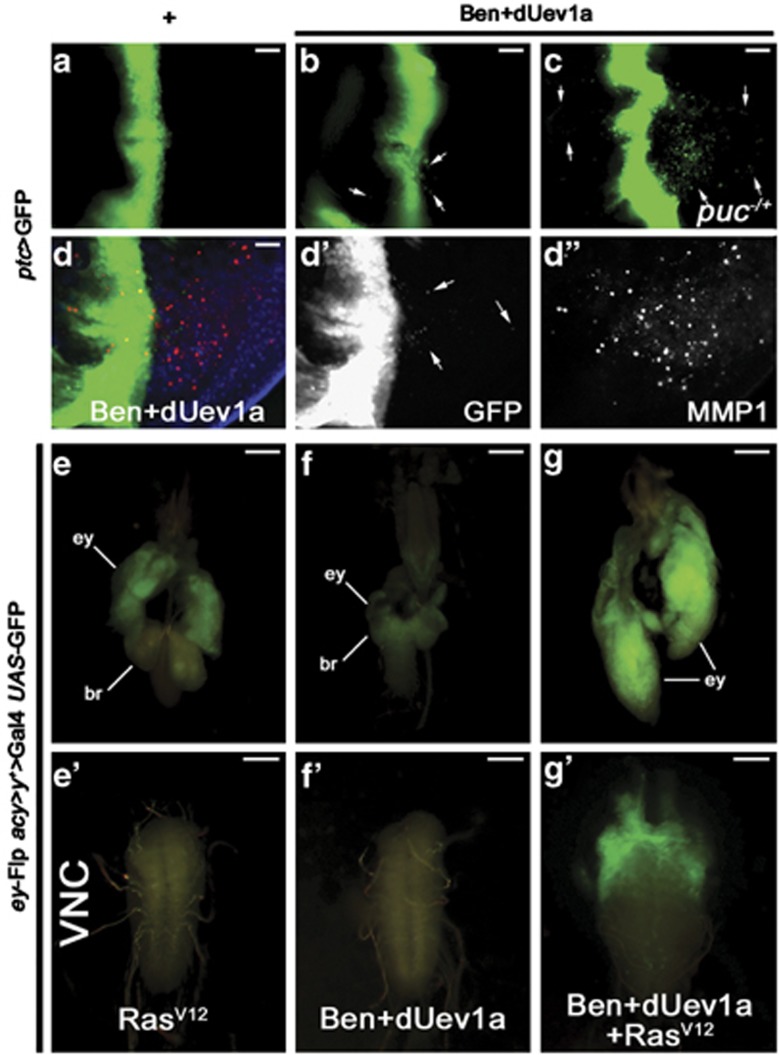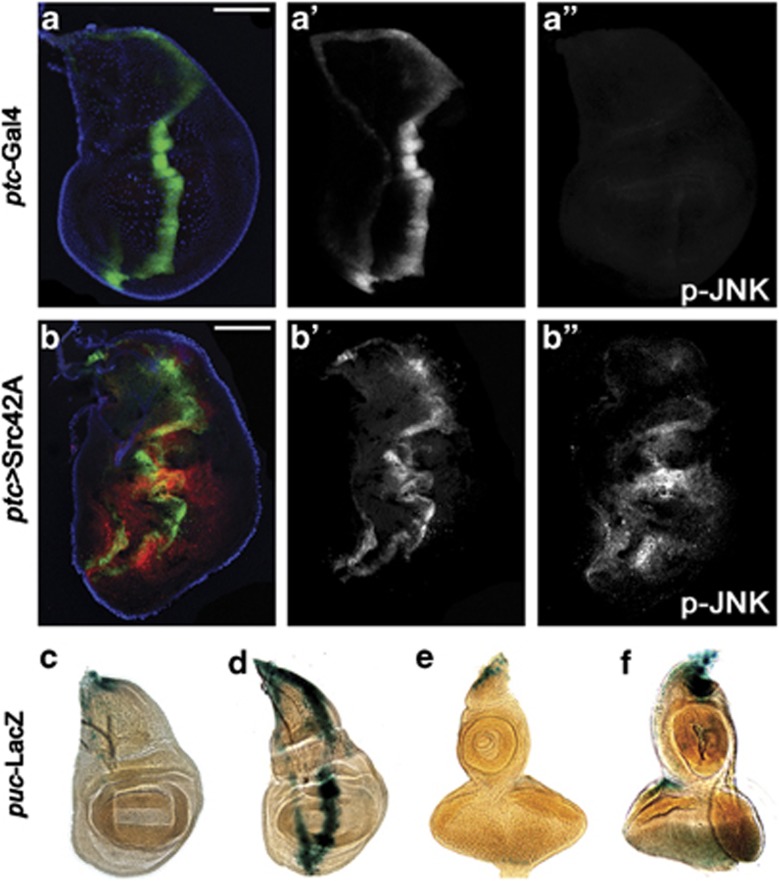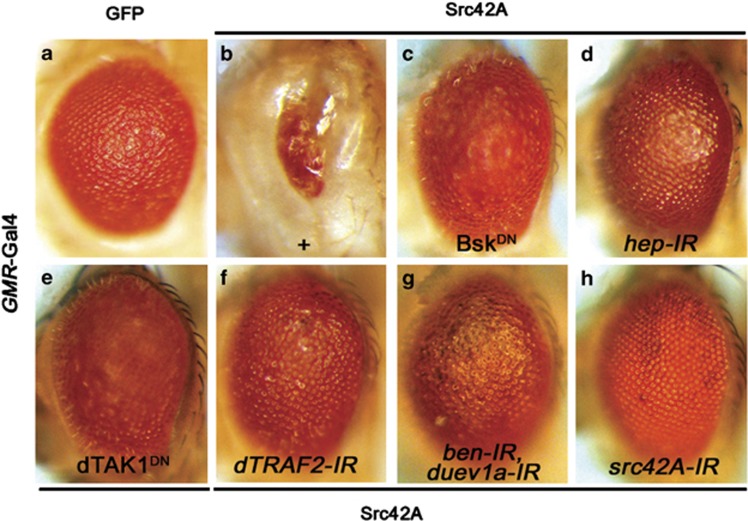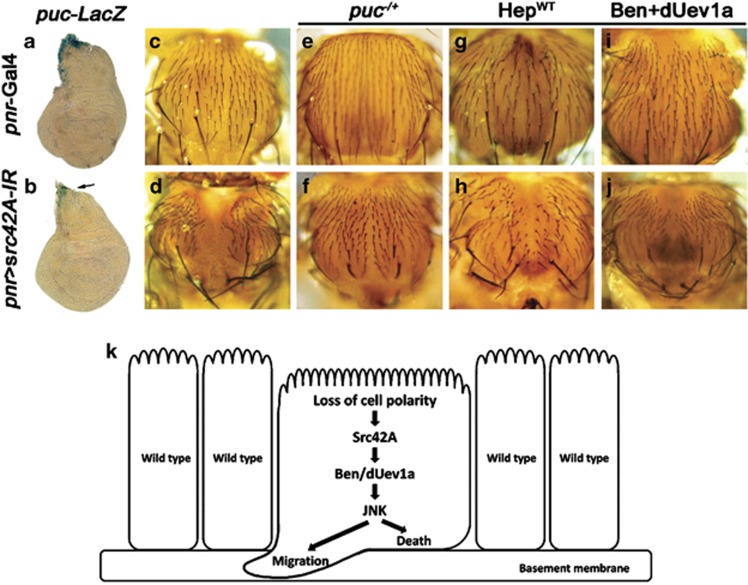Abstract
Loss of the cell polarity gene could cooperate with oncogenic Ras to drive tumor growth and invasion, which critically depends on the c-Jun N-terminal Kinase (JNK) signaling pathway in Drosophila. By performing a genetic screen, we have identified Src42A, the ortholog of mammalian Src, as a key modulator of both RasV12/lgl−/− triggered tumor invasion and loss of cell polarity gene-induced cell migration. Our genetic study further demonstrated that the Bendless (Ben)/dUev1a ubiquitin E2 complex is an essential regulator of Src42A-induced, JNK-mediated cell migration. Furthermore, we showed that ectopic Ben/dUev1a expression induced invasive cell migration along with increased MMP1 production in wing disc epithelia. Moreover, Ben/dUev1a could cooperate with RasV12 to promote tumor overgrowth and invasion. In addition, we found that the Ben/dUev1a complex is required for ectopic Src42A-triggered cell death and endogenous Src42A-dependent thorax closure. Our data not only provide a mechanistic insight into the role of Src in development and disease but also propose a potential oncogenic function for Ubc13 and Uev1a, the mammalian homologs of Ben and dUev1a.
Keywords: Src42A, invasion, cell death, JNK, Bendless, dUev1a
Cancer is the leading cause of death worldwide, causing an estimated total of 577 190 deaths in United States alone in 2012.1 Cancer-related mortalities are mainly caused by metastasis, rather than the primary tumor that arises from a malignant lesion.2 Although significant progress has been made towards the understanding of cancer development, the molecular and genetic mechanisms of tumor metastasis have remained poorly understood. With reduced genome redundancy and amenable genetic tools, Drosophila melanogaster has become an excellent model system to investigate the genetic mechanism of cancer biology over the past decades.3, 4, 5, 6 Several invasion and metastasis models have been established in both adult flies and developing larvae.4, 7, 8 In the eye–antennal discs, expression of oncogenic mutants, such as RasV12, can cooperate with mutants that disrupt cell polarity, such as scrib or lethal giant larvae (lgl), to induce invasive tumors into the ventral nerve cord (VNC).9, 10, 11 In the epithelia of the developing wing disc, loss of the cell polarity gene (scrib) or C-terminal SRC kinase (Csk) along the anterior/posterior (A/P) boundary using patched-Gal4 driver produces an invasive migration phenotype,12, 13, 14 which has been used to model cell migration in vivo.3
The c-Jun N-terminal Kinase (JNK) pathway is evolutionarily conserved from fly to human and has an essential role in regulating a wide range of cellular activities including proliferation, differentiation, migration and apoptosis.15 Recently, JNK signaling has been shown to have an important role in modulating RasV12/scrib−/−-triggered tumor growth and metastasis, as well as RafGOF/RhoGEF2-induced tumorgenesis.14, 16, 17
Src was the first discovered oncogene encoding a non-receptor membrane-associated tyrosine kinase.18, 19, 20 Nine Src family members have been identified in mammals, whereas the Drosophila genome encodes only two Src homologs, Src42A and Src64B.21, 22, 23 Src42A and Src64B have a redundant role in regulating dorsal closure and are both required for tracheal cell morphogenesis.24, 25 Recent studies found that Src64B could induce JNK-dependent overgrowth and expression of Yorkie's (Yki) target genes when cell death was blocked by expressing p35.26 When Src64B was overexpressed in a clone context, it induced non-autonomous tumor overgrowth through JNK-dependent propagation of Yki activity.27 Consistent with the well-documented role of Src family kinases in promoting mammalian tumor invasion,28 Cagan and colleagues found that inhibition of Csk, a negative regulator of Src family kinases, triggered JNK signaling-mediated cell invasion in Drosophila wing discs.13 However, a direct involvement of Src in tumor metastasis and cell invasion, and its underlying mechanisms, remain largely elusive.
We have performed a genetic screen and identified Src42A as a crucial regulator of RasV12/lgl−/−-induced tumor invasion, as well as the loss of scrib-triggered cell migration in development. Our genetic epistasis analysis demonstrated that Src42A modulates JNK signaling-mediated cell invasion, cell death and thorax closure upstream of Bendless (Ben) and dUev1a. Furthermore, we showed that ectopic expression of Ben/dUev1a not only induces cell migration and matrix metalloproteinase 1 (MMP1) upregulation but also cooperates with RasV12 to promote tumor growth and invasive behavior. Together, these data highlight the importance of Src42A-Ben/dUev1a-JNK signaling in regulating cell invasion and extend our knowledge towards the underlying mechanism of Src42A in tumor progression.
Results and discussion
Src42A is required for tumor invasion and cell migration
As previously described, co-expression of oncogenic Ras (RasV12) in lgl-mutant cells in eye–antenna discs using the ey-FLP/MARCM (mosaic analysis with a repressible cell marker) system induces strong tumor-like growths (Figure 1a), with invasive migration into the VNC 8 days after egg laying (AEL) (Figure 1a′).10, 16, 29 Such animals kept growing as oversized larvae carrying huge tumors in their head and died before pupation (Supplementary Figure S1A). Blocking JNK signaling by expressing the JNK phosphatase Puc dramatically suppressed the growth and invasion behaviors of RasV12/lgl−/− tumors (Figures 1b and b′).12, 16 To identify additional genes required for tumor growth and invasion, we performed a genetic screen for dominant suppressors of the RasV12/lgl−/− tumor progression phenotype and identified dUev1a as a crucial regulator.12 From this screen, we also found that the loss of src42A dramatically suppressed tumor cell invasion into the VNC (Figure 1c′) and enabled the animals to survive to the pupa stage (Supplementary Figure S1B), whereas the tumor size remained largely unaffected (compare Figures 1a and c). Loss of src64B produced a similar suppression effect (Supplementary Figure S2), consistent with previous finding that the two Drosophila Src proteins share redundant functions in development.24
Figure 1.
Src42A is required for Ras-lgl oncogenic cooperation and loss of scrib-induced invasion. (a–c) GFP-labeled clones of cells with indicated genotypes are created in the developing eye–antennal discs. RasV12/lgl−/−-induced tumor growth (a) and invasion of the VNC (a′) were dramatically suppressed by expressing Puc (b–b′). The invasion behavior was also strongly suppressed by expressing an src42A RNAi (c′), whereas the tumor overgrowth was not significantly changed (c). Scale bars, 200 μm in a–c and 100 μm in a′–c′. (d–f) Fluorescence micrographs of wing discs are shown. Compared with the control (d–d′′), loss of scrib-induced cell invasion and MMP1 expression (e–e′′) was suppressed by the expression of an src42A RNAi (f–f′′). Scale bars, 20 μm
To examine whether Src42A modulates cell invasion in other contexts, we turned to another well-characterized model in the larval wing imaginal disc.3, 12, 13, 30, 31, 32 Compared with the controls (Figures 1d–d′′), RNAi downregulation of the cell polarity gene scrib driven by ptc-Gal4 triggered strong cell migration phenotype towards the posterior part of the discs (Figure 1e′), along with JNK-dependent upregulation of matrix metalloprotease1 (MMP1, Figure 1e′′),12, 14 a protein that is essential for basement membrane degradation.29, 33 We found that the loss of src42A dramatically suppressed the epithelial migration phenotype as well as the upregulation of MMP1 (Figures 1f–f′′). Taken together, these data indicate that Src42A is required for RasV12/lgl−/−-triggered tumor invasion in the eye discs as well as the loss of cell-polarity-induced cell migration and MMP1 expression in the developing wing.
Src42A induce JNK-mediated cell migration through Ben/dUev1a
Ectopic expression of Src42A along the A/P boundary of wing imaginal discs driven by ptc-Gal4 (ptc>Src42A) resulted in strong cell migration phenotype along with the upregulation of MMP1 (Figures 2b–b′′′). To examine whether cell invasion is a primary consequence of Src42A activation, or a secondary effect of cell death triggered by elevated Src activity,34, 35, 36 we expressed the caspase inhibitor p35 to block cell death. Co-expression of p35 with Src42A resulted in a widening of the ptc domain and enhanced the production of MMP1 (Supplementary Figure S3). Importantly, these ‘undead cells'37, 38 can still migrate to the posterior part (Supplementary Figure S3), indicating that cell migration is a primary event induced by Src42A expression.
Figure 2.
Src42A induces JNK-mediated cell invasion in developing wings. Fluorescence micrographs of wing discs are shown. Compared with the controls (a–a′′′), ectopic Src42A expression-induced MMP1 secretion (b′) and cell invasion phenotype (b′′′) were completely suppressed by co-expressing of BskDN (c–c′′′). Scale bars, 100 μm in a–c and 20 μm in a′′′–c′′′
JNK signaling is misregulated in many human cancers and contributes to invasion in different Drosophila models.7, 13, 29, 31 We found that ptc>Src42A-induced cell migration and MMP1 induction (Figure 2b) were significantly suppressed by the expression of a dominant-negative form of Basket (Bsk) (Figure 2c), indicating that JNK signaling is required for Src42A-induced cell migration. We performed genetic epistasis analysis between Src42A and components of JNK signaling and found that ptc>Src42A-induced migration phenotype was significantly blocked by the loss of JNK kinase Hep, JNK Kinase Kinase dTAK1 and the E3 ubiquitin ligase dTRAF2 (Figure 3c), suggesting that Src42A induces cell migration upstream of dTRAF2.
Figure 3.
Src42A induces cell invasion through Ben/dUev1a. (a–b) Fluorescence micrographs of wing discs are shown. Ectopic Src42A expression-induced cell invasion (a′) and MMP1 secretion (a′′) were strongly suppressed by co-expressing a ben and dUev1a RNAi (b–b′′). Scale bars, 20 μm. (c) Quantification of invasion phenotype induced by Src42A expression. Results are shown as mean±S.D., n≥30. Student's t-test was used to compute P-values, significance is indicated with asterisks (***P<0.001, **P<0.01)
Our recent work identified the E2 ubiquitin-conjugating enzyme complex consisting of Bendless (Ben) and dUev1a as the upstream regulators of dTRAF2 in JNK signaling.12, 39 We explored the genetic interactions between the Src42A and Ben/dUev1a complex and found that ptc>Src42A-triggered migration phenotype and MMP1 expression (Figures 3a–a′′) were suppressed strongly by RNAi downregulation of either Ben or dUev1a alone (Figure 3c), and completely by both (Figures 3 b–b′′), suggesting that the Ben/dUev1a complex is necessary for Src42A-induced cell migration. We previously showed that co-expression of Ben and dUev1a resulted in JNK activation;12 consistently, Ben and dUev1a expression along the A/P boundary induced a mild cell migration phenotype and upregulation of MMP1 (Figures 4a), which was significantly enhanced by removing one copy of endogenous puc (Figure 4c), indicating that Ben/dUev1a expression could induce JNK-dependent cell migration.
Figure 4.
Ben/dUev1a expression promotes tumor growth and metastasis of RasV12 cells. (a–d) Fluorescence micrographs of wing discs are shown. Compared with the controls (a), Ben/dUev1a expression induced mild cell invasion phenotype (b) was intensely enhanced by deleting one copy of endogenous puc (c). Ben/dUev1a expression under the ptc promoter upregulates MMP1 secretion. Crosses were performed at 29 °C. Scale bars, 20 μm. (e–g) Dorsal views of the cephalic complexes (e–g) and NVCs are shown (e′–g′). RasV12-expressing clones show a moderate growth advantage (e), but never invade into NVC (e′). Clones with elevated Ben/dUev1a activity gave no obvious overgrowth or invasion phenotypes (f–f′). Massive tumor growth (g) and invasion to the VNC (g) were observed by co-expression of RasV12 and Ben/dUev1a. Scale bars, 200 μm in (e–g) and 100 μm in (e′–g′)
Together, the above data suggested that the Ben/dUev1a complex is necessary and sufficient for Src42A-induced JNK-dependent cell migration.
Ben/dUev1a cooperates with Ras V12 to induce tumor growth and invasion
Gain of function of cell morphology regulators or loss of cell polarity could promote JNK-dependent cell migration and cooperate with RasV12 to drive tumor growth and invasion.36, 40 As Ben/dUev1a expression could also induce JNK-dependent cell migration, we wonder whether Ben/dUev1a could cooperate with RasV12 to promote tumor progression. As reported previously, clonal expression of RasV12 in eye disc induced benign overgrowth (Figure 4e), with no cells invading into the VNC (Figure 4e′).16 On the other hand, expression of Ben/dUev1a resulted in no obvious growth or invasion phenotype (Figures 4f and f′). When Ben/dUev1a was simultaneously expressed with RasV12, tumor overgrowth (Figure 4g) and invasion into the VNC region (Figure 4g′) were observed in the eye discs 8 days AEL, suggesting that Ben/dUev1a could cooperate with RasV12 to promote tumor growth and invasion behavior.
Src42A activates JNK signaling in vivo
To investigate whether Src42A activates JNK signaling in vivo, we examined JNK phosphorylation and puc expression, a read-out of JNK activity,41 in response to Src42 expression. We found that ectopic expression of Src42A under the ptc promoter in the wing disc resulted in strong JNK phosphorylation (compare Figures 5a and b) and expression of a puc-LacZ reporter (Figures 5c and d). Furthermore, ectopic Src42A expression driven by GMR-Gal4 is sufficient to activate puc transcription in developing eye discs (Figures 5e and f). Together, these results indicate that Src42A can activate JNK signaling in vivo.
Figure 5.
Src42A expression activates JNK in vivo. (a–b) Fluorescence micrographs of wing discs are shown. Compared with the controls (a), Src42A expression induced strong JNK phosphorylation (b). Scale bars, 100 μm. (c–f) X-Gal staining of the puc-LacZ reporter gene in the developing wing (c–d) and eye (e–f) are shown. Ectopic Src42A expression under the ptc promoter strongly upregulated puc expression along the A/P boundary (d). The weak endogenous puc expression posterior to the morphogenetic furrow of eye disc (e) was significantly enhanced by expressing a wild-type Src42A (f)
Src42A triggers JNK-dependent cell death in the developing eye
Apart from the role of Src42A in regulating tumor invasion and cell migration showed above, we and others35, 36 also found that ectopic Src42A expression in developing eyes could induce extensive cell death, as shown with acridine orange (AO) staining (Supplementary Figure S4B) that detects dying cells42 and produce a small eye phenotype (Figure 6b). Consistent with the genetic epistasis analysis in cell invasion, the GMR>Src42A-triggered cell death and small eye phenotype were dramatically suppressed by inactivation of Ben, dUev1a or downstream components of the JNK signaling (Supplementary Figure S4 and Figures 6c–g). Besides, the ectopic Src42A-caused small eye phenotype was also reverted by co-expressing two independent RNAi lines against src42A (Figure 6h and Supplementary Figure S5), which further confirmed the efficiency of the two RNAi lines.
Figure 6.
Src42A induces Ben/dUev1a-mediated cell death in developing eyes. Light micrographs of Drosophila adult eyes are shown. Compared with the wild-type eye (a), the GMR>Src42A small eye phenotype (b) was dramatically suppressed by the expression of BskDN (c), a hep RNAi (d), dTAK1DN (e), a dTRAF2 RNAi (f), reducing ben and dUev1a activity (g), or a src42A RNAi (h)
Ben/dUev1a is physiologically required for Src42A
Apart from its role in modulating cell migration and cell death, src42A also regulates JNK-dependent dorsal closure.24 Consistently, JNK signaling, as revealed by puc expression, is activated in the dorsal patch of the third instar larval wing disc (Figure 7a).43 Downregulation of src42A under the pannier (pnr) promoter resulted in reduced puc expression in the wing disc (Figure 7b) and produced a cleft phenotype in the adult thorax (Figure 7d). This cleft phenotype resembled that of JNK inactivation22 and could be partially rescued by deleting one copy of endogenous puc (Figure 7f), or expression of a wild-type Hep (HepWT) (Figure 7h), or co-expression of Ben and dUev1a (Figure 7j). Together, these results suggested that the Ben/dUev1a complex is required for the physiological function of Src42A in thorax development.
Figure 7.
Src42A modulates endogenous JNK activity upstream of Ben/dUev1a. (a–b) X-Gal staining of the puc-LacZ reporter gene in the developing wing are shown. The endogenous puc expression pattern in the notum region of wild-type wing disc (a) was reduced by expressing a src42A RNAi ((b) indicated by the arrow head). (c–j) Light micrographs of Drosophila adult thoraxes are shown. Compared with the controls (c), loss of src42A-produced strong thorax cleft phenotype (d) was restored by deleting on copy of puc (f), overexpression of Hep (h) or overexpression of Ben/dUev1a (j), whereas loss of puc, expression of Hep or Ben/dUev1a alone gave no obvious phenotype (e, g, i respectively). (k) A schematic diagram of Ben/dUev1a-JNK signaling in regulating Src42A-induced cell migration and death
Conclusion
We have identified Src42A as a key modulator of both RasV12/lgl−/−-triggered tumor invasion and loss of cell-polarity-induced cell migration in Drosophila. Our genetic evidence established the Ben/dUev1a complex as an essential positive regulator that mediates Src42A-induced, JNK-dependent cell migration and death (Figure 7k). We showed that ectopic Ben/dUev1a expression not only induced MMP1 upregulation and cell migration but also cooperated with RasV12 to promote tumor growth and invasion, suggesting that Ben and dUev1a are candidate proto-oncogenes. Consistent with our findings, Uev1A, the mammalian homolog of dUev1a, is upregulated in many human cancer cell lines.44, 45 Our data suggested a link between Src activation and Ben/dUev1a-JNK signaling in regulating cell migration and death in development and disease, which provided beneficial information for mammalian studies and target therapies for cancer.
Materials and Methods
Drosophila strains and generation of clones
All stocks were raised on standard Drosophila media, and crosses were performed at 25 °C unless otherwise indicated. Fluorescently labeled invasive tumors were produced in the eye discs as previously described10 using the following strains: y, w, ey-Flp; tub-Gal80, FRT40A; Act>y+>Gal4, UAS-GFP (40A tester), lgl4 FRT40A UAS-RasV12 (40A tester) and ey-Flp, Act>y+>Gal4, UAS-GFP. Additional strains, including GMR-Gal4, ptc-Gal4, pnr-Gla4, UAS-p35, UAS-GFP and UAS-Src42ACA, were obtained from Bloomington stock center; UAS-ben-IR (no. 9413) and UAS-src42A-IR (no. 26019) were obtained from the VDRC center; UAS-dTAK1-IR, UAS-BskDN, UAS-hep-IR, UAS-dTRAF2-IR, UAS-Puc, pucE69,46 UAS-src42A-IR,25 UAS-src64B-IR,47 UAS-Src42A,35 UAS-BenT8, UAS-dUev1a, UAS-dUev1a-IR and UAS-scrib-IR12, 39 were previously described. Genotypes of flies used in each figure can be found in online Supplementary Information.
Immunohistochemistry
Antibody staining of imaginal discs was performed as previously described.16 The following antibodies were used: rabbit anti-phospho-JNK (1 : 200, Calbiochem, San Diego, CA, USA), mouse anti-MMP1 (1 : 200, Developmental Studies Hybridoma Bank, Iowa City, IA, USA). Secondary antibodies were anti-rabbit-Alexa (1 : 1000, Cell Signaling Technology, Danvers, MA, USA) and anti-mouse-Cy3 (1 : 1000, Jackson Immuno Research, West Grove, PA, USA).
X-gal staining
Eye and wing discs were dissected from the third instar larvae in PBT (1 × PBS pH 7.0, 0.1% Triton X 100) and stained for β-galactosidase activity as described.48
AO staining
Eye and wing discs were dissected from the third instar larvae in PBT and incubated in 1 × 10−5 M AO for 5 min at room temperature prior to imaging.
Acknowledgments
We thank Bloomington, VDRC and NIG stock centers for fly stocks, Edward Yao for critical reading of the manuscript, and Yujia Hu for statistical assistance. This work was supported by the National Basic Research Program of China (973 Program) (2010CB944901, 2011CB943903), National Natural Science Foundation of China (31071294, 31171413, 31371490), the Specialized Research Fund for the Doctoral Program of Higher Education of China (20120072110023, 20120072120030) and Shanghai Committee of Science and Technology (09DZ2260100).
Glossary
- VNC
ventral nerve cord
- JNK
c-Jun N-terminal Kinase
- MMP1
matrix metalloproteinase 1
- AEL
after egg laying
- A/P
anterior/posterior
- AO
acridine orange
- MARCM
mosaic analysis with a repressible cell marker
- Ey
eyeless
The authors declare no conflict of interest.
Footnotes
Supplementary Information accompanies this paper on Cell Death and Disease website (http://www.nature.com/cddis)
Edited by M Agostini
Supplementary Material
References
- Siegel R, Naishadham D, Jemal A. Cancer statistics, 2012. CA Cancer J Clin. 2012;62:10–29. doi: 10.3322/caac.20138. [DOI] [PubMed] [Google Scholar]
- Valastyan S, Weinberg RA. Tumor metastasis: molecular insights and evolving paradigms. Cell. 2011;147:275–292. doi: 10.1016/j.cell.2011.09.024. [DOI] [PMC free article] [PubMed] [Google Scholar]
- Miles WO, Dyson NJ, Walker JA. Modeling tumor invasion and metastasis in Drosophila. Dis Model Mech. 2011;4:753–761. doi: 10.1242/dmm.006908. [DOI] [PMC free article] [PubMed] [Google Scholar]
- Gonzalez C. Drosophila melanogaster: a model and a tool to investigate malignancy and identify new therapeutics. Nat Rev Cancer. 2013;13:172–183. doi: 10.1038/nrc3461. [DOI] [PubMed] [Google Scholar]
- Willoughby LF, Schlosser T, Manning SA, Parisot JP, Street IP, Richardson HE, et al. An in vivo large-scale chemical screening platform using Drosophila for anti-cancer drug discovery. Dis Model Mech. 2013;6:521–529. doi: 10.1242/dmm.009985. [DOI] [PMC free article] [PubMed] [Google Scholar]
- Elsum I, Yates L, Humbert PO, Richardson HE. The Scribble-Dlg-Lgl polarity module in development and cancer: from flies to man. Essays Biochem. 2012;53:141–168. doi: 10.1042/bse0530141. [DOI] [PubMed] [Google Scholar]
- Rudrapatna VA, Cagan RL, Das TK. Drosophila cancer models. Dev Dyn. 2012;241:107–118. doi: 10.1002/dvdy.22771. [DOI] [PMC free article] [PubMed] [Google Scholar]
- Brumby AM, Richardson HE. Using Drosophila melanogaster to map human cancer pathways. Nat Rev Cancer. 2005;5:626–639. doi: 10.1038/nrc1671. [DOI] [PubMed] [Google Scholar]
- Brumby AM, Richardson HE. scribble mutants cooperate with oncogenic Ras or Notch to cause neoplastic overgrowth in Drosophila. EMBO J. 2003;22:5769–5779. doi: 10.1093/emboj/cdg548. [DOI] [PMC free article] [PubMed] [Google Scholar]
- Pagliarini RA, Xu T. A genetic screen in Drosophila for metastatic behavior. Science. 2003;302:1227–1231. doi: 10.1126/science.1088474. [DOI] [PubMed] [Google Scholar]
- Wu M, Pastor-Pareja JC, Xu T. Interaction between Ras(V12) and scribbled clones induces tumour growth and invasion. Nature. 2010;463:545–548. doi: 10.1038/nature08702. [DOI] [PMC free article] [PubMed] [Google Scholar]
- Ma X, Yang L, Yang Y, Li M, Li W, Xue L. dUev1a modulates TNF-JNK mediated tumor progression and cell death in Drosophila. Dev Biol. 2013;380:211–221. doi: 10.1016/j.ydbio.2013.05.013. [DOI] [PubMed] [Google Scholar]
- Vidal M, Larson DE, Cagan RL. Csk-deficient boundary cells are eliminated from normal Drosophila epithelia by exclusion, migration, and apoptosis. Dev Cell. 2006;10:33–44. doi: 10.1016/j.devcel.2005.11.007. [DOI] [PubMed] [Google Scholar]
- Cordero JB, Macagno JP, Stefanatos RK, Strathdee KE, Cagan RL, Vidal M. Oncogenic Ras diverts a host TNF tumor suppressor activity into tumor promoter. Dev Cell. 2010;18:999–1011. doi: 10.1016/j.devcel.2010.05.014. [DOI] [PMC free article] [PubMed] [Google Scholar]
- Weston CR, Davis RJ. The JNK signal transduction pathway. Curr Opin Cell Biol. 2007;19:142–149. doi: 10.1016/j.ceb.2007.02.001. [DOI] [PubMed] [Google Scholar]
- Igaki T, Pagliarini RA, Xu T. Loss of cell polarity drives tumor growth and invasion through JNK activation in Drosophila. Curr Biol. 2006;16:1139–1146. doi: 10.1016/j.cub.2006.04.042. [DOI] [PubMed] [Google Scholar]
- Khoo P, Allan K, Willoughby L, Brumby AM, Richardson HE. In Drosophila, RhoGEF2 cooperates with activated Ras in tumorigenesis through a pathway involving Rho1-Rok-Myosin-II and JNK signalling. Dis Model Mech. 2013;6:661–678. doi: 10.1242/dmm.010066. [DOI] [PMC free article] [PubMed] [Google Scholar]
- Yeatman TJ. A renaissance for SRC. Nat Rev Cancer. 2004;4:470–480. doi: 10.1038/nrc1366. [DOI] [PubMed] [Google Scholar]
- Thomas SM, Brugge JS. Cellular functions regulated by Src family kinases. Annu Rev Cell Dev Biol. 1997;13:513–609. doi: 10.1146/annurev.cellbio.13.1.513. [DOI] [PubMed] [Google Scholar]
- Parsons SJ, Parsons JT. Src family kinases, key regulators of signal transduction. Oncogene. 2004;23:7906–7909. doi: 10.1038/sj.onc.1208160. [DOI] [PubMed] [Google Scholar]
- Simon MA, Drees B, Kornberg T, Bishop JM. The nucleotide sequence and the tissue-specific expression of Drosophila c-src. Cell. 1985;42:831–840. doi: 10.1016/0092-8674(85)90279-x. [DOI] [PubMed] [Google Scholar]
- Takahashi F, Endo S, Kojima T, Saigo K. Regulation of cell-cell contacts in developing Drosophila eyes by Dsrc41, a new, close relative of vertebrate c-src. Genes Dev. 1996;10:1645–1656. doi: 10.1101/gad.10.13.1645. [DOI] [PubMed] [Google Scholar]
- Dodson GS, Guarnieri DJ, Simon MA. Src64 is required for ovarian ring canal morphogenesis during Drosophila oogenesis. Development. 1998;125:2883–2892. doi: 10.1242/dev.125.15.2883. [DOI] [PubMed] [Google Scholar]
- Tateno M, Nishida Y, Adachi-Yamada T. Regulation of JNK by Src during Drosophila development. Science. 2000;287:324–327. doi: 10.1126/science.287.5451.324. [DOI] [PubMed] [Google Scholar]
- Shindo M, Wada H, Kaido M, Tateno M, Aigaki T, Tsuda L, et al. Dual function of Src in the maintenance of adherens junctions during tracheal epithelial morphogenesis. Development. 2008;135:1355–1364. doi: 10.1242/dev.015982. [DOI] [PubMed] [Google Scholar]
- Fernandez BG, Jezowska B, Janody F.Drosophila actin-Capping Protein limits JNK activation by the Src proto-oncogene Oncogene 2013. e-pub ahead of print 3 May 2013;doi: 10.1038/onc.2013.155 [DOI] [PubMed]
- Enomoto M, Igaki T. Src controls tumorigenesis via JNK-dependent regulation of the Hippo pathway in Drosophila. EMBO Rep. 2013;14:65–72. doi: 10.1038/embor.2012.185. [DOI] [PMC free article] [PubMed] [Google Scholar]
- Guarino M. Src signaling in cancer invasion. J Cell Physiol. 2010;223:14–26. doi: 10.1002/jcp.22011. [DOI] [PubMed] [Google Scholar]
- Uhlirova M, Bohmann D. JNK- and Fos-regulated Mmp1 expression cooperates with Ras to induce invasive tumors in Drosophila. EMBO J. 2006;25:5294–5304. doi: 10.1038/sj.emboj.7601401. [DOI] [PMC free article] [PubMed] [Google Scholar]
- Rudrapatna VA, Bangi E, Cagan RL. Caspase signalling in the absence of apoptosis drives Jnk-dependent invasion. EMBO Rep. 2013;14:172–177. doi: 10.1038/embor.2012.217. [DOI] [PMC free article] [PubMed] [Google Scholar]
- Rudrapatna VA, Bangi E, Cagan RL.A Jnk-Rho-Actin remodeling positive feedback network directs Src-driven invasion Oncogene 2013. e-pub ahead of print 8 July 2013;doi: 10.1038/onc.2013.232 [DOI] [PubMed]
- Portela M, Richardson HE. Death takes a holiday--non-apoptotic role for caspases in cell migration and invasion. EMBO Rep. 2013;14:107–108. doi: 10.1038/embor.2012.224. [DOI] [PMC free article] [PubMed] [Google Scholar]
- Srivastava A, Pastor-Pareja JC, Igaki T, Pagliarini R, Xu T. Basement membrane remodeling is essential for Drosophila disc eversion and tumor invasion. Proc Natl Acad Sci USA. 2007;104:2721–2726. doi: 10.1073/pnas.0611666104. [DOI] [PMC free article] [PubMed] [Google Scholar]
- Singh J, Aaronson SA, Mlodzik M. Drosophila Abelson kinase mediates cell invasion and proliferation through two distinct MAPK pathways. Oncogene. 2010;29:4033–4045. doi: 10.1038/onc.2010.155. [DOI] [PMC free article] [PubMed] [Google Scholar]
- Pedraza LG, Stewart RA, Li DM, Xu T. Drosophila Src-family kinases function with Csk to regulate cell proliferation and apoptosis. Oncogene. 2004;23:4754–4762. doi: 10.1038/sj.onc.1207635. [DOI] [PubMed] [Google Scholar]
- Vidal M, Warner S, Read R, Cagan RL. Differing Src signaling levels have distinct outcomes in Drosophila. Cancer Res. 2007;67:10278–10285. doi: 10.1158/0008-5472.CAN-07-1376. [DOI] [PMC free article] [PubMed] [Google Scholar]
- Huh JR, Guo M, Hay BA. Compensatory proliferation induced by cell death in the Drosophila wing disc requires activity of the apical cell death caspase Dronc in a nonapoptotic role. Curr Biol. 2004;14:1262–1266. doi: 10.1016/j.cub.2004.06.015. [DOI] [PubMed] [Google Scholar]
- Ryoo HD, Gorenc T, Steller H. Apoptotic cells can induce compensatory cell proliferation through the JNK and the Wingless signaling pathways. Dev Cell. 2004;7:491–501. doi: 10.1016/j.devcel.2004.08.019. [DOI] [PubMed] [Google Scholar]
- Ma X, Huang J, Yang L, Yang Y, Li W, Xue L. NOPO modulates Egr-induced JNK-independent cell death in Drosophila. Cell Res. 2012;22:425–431. doi: 10.1038/cr.2011.135. [DOI] [PMC free article] [PubMed] [Google Scholar]
- Brumby AM, Goulding KR, Schlosser T, Loi S, Galea R, Khoo P, et al. Identification of novel Ras-cooperating oncogenes in Drosophila melanogaster: a RhoGEF/Rho-family/JNK pathway is a central driver of tumorigenesis. Genetics. 2011;188:105–125. doi: 10.1534/genetics.111.127910. [DOI] [PMC free article] [PubMed] [Google Scholar]
- Agnes F, Suzanne M, Noselli S. The Drosophila JNK pathway controls the morphogenesis of imaginal discs during metamorphosis. Development. 1999;126:5453–5462. doi: 10.1242/dev.126.23.5453. [DOI] [PubMed] [Google Scholar]
- Abrams JM, White K, Fessler LI, Steller H. Programmed cell death during Drosophila embryogenesis. Development. 1993;117:29–43. doi: 10.1242/dev.117.1.29. [DOI] [PubMed] [Google Scholar]
- Campuzano S, Modolell J. Patterning of the Drosophila nervous system: the achaete-scute gene complex. Trends Genet. 1992;8:202–208. doi: 10.1016/0168-9525(92)90234-u. [DOI] [PubMed] [Google Scholar]
- Xiao W, Lin SL, Broomfield S, Chow BL, Wei YF. The products of the yeast MMS2 and two human homologs (hMMS2 and CROC-1) define a structurally and functionally conserved Ubc-like protein family. Nucleic Acids Res. 1998;26:3908–3914. doi: 10.1093/nar/26.17.3908. [DOI] [PMC free article] [PubMed] [Google Scholar]
- Syed NA, Andersen PL, Warrington RC, Xiao W. Uev1A a ubiquitin conjugating enzyme variant, inhibits stress-induced apoptosis through NF-kappaB activation. Apoptosis. 2006;11:2147–2157. doi: 10.1007/s10495-006-0197-3. [DOI] [PubMed] [Google Scholar]
- Xue L, Igaki T, Kuranaga E, Kanda H, Miura M, Xu T. Tumor suppressor CYLD regulates JNK-induced cell death in Drosophila. Dev Cell. 2007;13:446–454. doi: 10.1016/j.devcel.2007.07.012. [DOI] [PubMed] [Google Scholar]
- Pechkovsky A, Lahav M, Bitman E, Salzberg A, Kleinberger T. E4orf4 induces PP2A- and Src-dependent cell death in Drosophila melanogaster and at the same time inhibits classic apoptosis pathways. Proc Natl Acad Sci USA. 2013;110:E1724–E1733. doi: 10.1073/pnas.1220282110. [DOI] [PMC free article] [PubMed] [Google Scholar]
- Xue L, Noll M. Drosophila female sexual behavior induced by sterile males showing copulation complementation. Proc Natl Acad Sci USA. 2000;97:3272–3275. doi: 10.1073/pnas.060018897. [DOI] [PMC free article] [PubMed] [Google Scholar]
Associated Data
This section collects any data citations, data availability statements, or supplementary materials included in this article.



